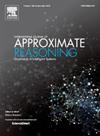Incremental attribute reduction with α,β-level intuitionistic fuzzy sets
IF 3.2
3区 计算机科学
Q2 COMPUTER SCIENCE, ARTIFICIAL INTELLIGENCE
引用次数: 0
Abstract
The intuitionistic fuzzy set theory is recognized as an effective approach for attribute reduction in decision information systems containing numerical or continuous data, particularly in cases of noisy data. However, this approach involves complex computations due to the participation of both the membership and non-membership functions, making it less feasible for data tables with a large number of objects. Additionally, in some practical scenarios, dynamic data tables may change in the number of objects, such as the addition or removal of objects. To overcome these challenges, we propose a novel and efficient incremental attribute reduction method based on -level intuitionistic fuzzy sets. Specifically, we first utilize the key properties of -level intuitionistic fuzzy sets to construct a distance measure between two -level intuitionistic fuzzy partitions. This extension of the intuitionistic fuzzy set model helps reduce noise in the data and shrink the computational space. Subsequently, we define a new reduct and design an efficient algorithm to identify an attribute subset in fixed decision tables. For dynamic decision tables, we develop two incremental calculation formulas based on the distance measure between two -level intuitionistic fuzzy partitions to improve processing time. Accordingly, some important properties of the distance measures are also clarified. Finally, we design two incremental attribute reduction algorithms that handle the addition and removal of objects. Experimental results have demonstrated that our method is more effective than incremental methods based on fuzzy rough set and intuitionistic fuzzy set approaches in terms of execution time and classification accuracy from the obtained reduct.
用 α、β 级直观模糊集递减属性
在包含数值或连续数据的决策信息系统中,直觉模糊集理论被认为是一种有效的属性还原方法,尤其是在有噪声数据的情况下。然而,由于成员和非成员函数的参与,这种方法涉及复杂的计算,因此对于对象数量较多的数据表来说不太可行。此外,在某些实际场景中,动态数据表的对象数量可能会发生变化,例如对象的添加或删除。为了克服这些挑战,我们提出了一种基于 α、β 级直觉模糊集的新型高效增量属性缩减方法。具体来说,我们首先利用 α,β 级直觉模糊集的关键属性来构建两个 α,β 级直觉模糊分区之间的距离度量。对直观模糊集模型的这一扩展有助于减少数据中的噪声,缩小计算空间。随后,我们定义了一种新的还原法,并设计了一种高效算法来识别固定决策表中的属性子集。对于动态决策表,我们根据两个 α、β 级直觉模糊分区之间的距离度量开发了两个增量计算公式,以缩短处理时间。相应地,我们还阐明了距离度量的一些重要属性。最后,我们设计了两种增量属性缩减算法来处理对象的添加和删除。实验结果表明,与基于模糊粗糙集和直观模糊集方法的增量方法相比,我们的方法在执行时间和从获得的还原中分类的准确性方面更有效。
本文章由计算机程序翻译,如有差异,请以英文原文为准。
求助全文
约1分钟内获得全文
求助全文
来源期刊

International Journal of Approximate Reasoning
工程技术-计算机:人工智能
CiteScore
6.90
自引率
12.80%
发文量
170
审稿时长
67 days
期刊介绍:
The International Journal of Approximate Reasoning is intended to serve as a forum for the treatment of imprecision and uncertainty in Artificial and Computational Intelligence, covering both the foundations of uncertainty theories, and the design of intelligent systems for scientific and engineering applications. It publishes high-quality research papers describing theoretical developments or innovative applications, as well as review articles on topics of general interest.
Relevant topics include, but are not limited to, probabilistic reasoning and Bayesian networks, imprecise probabilities, random sets, belief functions (Dempster-Shafer theory), possibility theory, fuzzy sets, rough sets, decision theory, non-additive measures and integrals, qualitative reasoning about uncertainty, comparative probability orderings, game-theoretic probability, default reasoning, nonstandard logics, argumentation systems, inconsistency tolerant reasoning, elicitation techniques, philosophical foundations and psychological models of uncertain reasoning.
Domains of application for uncertain reasoning systems include risk analysis and assessment, information retrieval and database design, information fusion, machine learning, data and web mining, computer vision, image and signal processing, intelligent data analysis, statistics, multi-agent systems, etc.
 求助内容:
求助内容: 应助结果提醒方式:
应助结果提醒方式:


